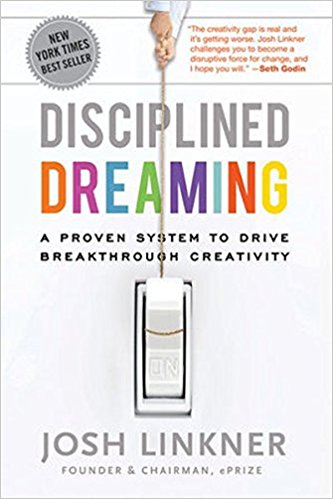Disciplined Dreaming Summary

5 min read ⌚
 A Proven System to Drive Breakthrough Creativity
A Proven System to Drive Breakthrough Creativity
Creativity is an interesting topic ever since the beginning of civilization. Creativity is no longer necessary for art; it is vital in each aspect of life and business as well. Each organization must implement it in every department.
However, why is that the case? Why do we need to be increasingly creative in today’s economy? Is there a way to make your creative process more structured and deliberate?
Of course, there is.
What are the steps? We try to summarize them for you in this “Disciplined Dreaming” summary.
Who Should Read “Disciplined Dreaming”? and Why?
We live in a fast-paced world, where the only way to sustain growth is through creativity implemented at all levels of your company. “Disciplined Dreaming” shows you how to come up with new ideas, how to create a creative culture in your organization, and thus make your employees be creative, and survive in the highly competitive world.
The methodology Linkner provides is simple and based on actual results. We recommend this book to individuals, teams, and organizations that want to become better at meeting the creative challenges posed by the modern marketplace.
About Josh Linkner
 Josh Linkner is the founder and chairman of ePrize and the CEO of Detroit Venture Partners.
Josh Linkner is the founder and chairman of ePrize and the CEO of Detroit Venture Partners.
“Disciplined Dreaming Summary”
Many people wrongly think that only an organization’s leaders should be imaginative and creative, or that many occupations or roles do not require creativity. Others imagine that learning and specialized aptitudes are sufficient resources for success.
Some believe that creativity is a natural gift and that you cannot manage it on a corporate level.
If you are one of those people, you are wrong.
First, each activity can benefit from applying creativity. Second, each can figure out how to become more creative. Third, each association needs creativity to survive in the competitive market, and your organization can, and as a matter of fact – must manage its employees’ creativity.
However, why is creativity so important?
Bigger commoditization, the quickening pace of business, lower barriers for entering the markets and reduced expenses for producing new goods drive the increasing requirement for creativity. Numerous leaders know they cannot address these difficulties without creativity, and perceive that their companies do not have enough of it.
To make you and your organization more creative, take after the systematic “Disciplined Dreaming” process.
What is Disciplined Dreaming?
It is a process that includes five steps: ask, prepare, discover, ignite and launch. You should become acclimated to working deliberately on creativity.
Do not worry; it gets less demanding with time.
As days go by, you will deal more effectively with uncertainty and learn to adjust to market changes rapidly. Your reactions to issues will be more inventive in each area, from day to day issues to game-changing advancements, and you will commit fewer errors in the process.
Furthermore, you will broaden your definition of creativity and imagination and turn out to be better at perceiving stages in the process, so that “trenches” will be less disappointing.
You will additionally know when to look for contribution from others.
The creative process always has a somewhat messy part. It does not continue in programmed, straight steps. Instead, getting lost and multiplying are often necessary.
However, stay assured, following the guide of Disciplined Dreaming will guarantee that when you get lost, you can still create remunerating results.
Key Lessons from Disciplined Dreaming
1. Ask and Prepare
2. Discover and Ignite
3. Launch!
Ask and Prepare
Define the issue you need to solve. This is your Creativity Challenge, and it communicates where you want to wind up. Portray your optimal objective in one sentence. Study your circumstances. It is not sufficient to think of an answer; you have to influence your colleagues to grasp it as well. Pinpoint your target group. Develop a plan for the project. Break it into little parts. Distinguish your expectations and the markers on your timetable to delivery. Define your key measurements. Identify three to five performance pointers.
Next, make a general commitment to building up a culture that esteems and maintains creativity. Such cultures are different in specific details yet have a typical sense of duty regarding specific basic standards. Creative cultures celebrate and empowering ideas. They additionally maintain a strategic distance from conformity, they concentrate on the current activities, and they are clear about their identity and where they stand in the creative process.
Place yourself in the correct mindset and set up your physical environment. Give tools that the creative culture’s members can apply to their exercises and that help them as they seek after their ventures.
Find and Ignite
You do not need to create all of your ideas from scratch. In fact, doing so is inefficient, since the world overflows with ideas.
Rather than trying hard to think of new ideas, you can find them. Taking a gander at the world and your specific creative undertakings from alternate points of view are vital to this kind of disclosure.
People limit themselves by supposing they need a whole imaginative project happen in a flash, with every element resolved. However, that is not how creativity works.
In this stage, it is enough to focus on producing, perceiving and securing creative sparkles.
Launch!
The final stage in the process is to launch your ideas. First, sort and assess your generated ideas, next choose the best, and then breathe life into them. In prior stages, you purposefully repressed the judging side of your brain. Welcome that angle back so you can evaluate your thoughts using your capacities and thoroughness. Utilize numerous tools to assess your ideas. Attempt the classical “Matrix Approach,” the “Poker Chip Method,” “Trial by Jury,” or “Esteem Mapping.
Furthermore, when you pick an idea, test it. Prototyping utilizing reenactments function admirably. Recounting a story or making a film about the idea are alternative solutions. For measurements, pick a bunch of critical criteria to gauge the success of the idea. Standardize and quantify these measures so outsiders can comprehend them, make a “scorecard” to track your prosperity, incorporate them into your plan and… start!
Like this summary? We’d Like to invite you to download our free 12 min app, for more amazing summaries and audiobooks.
“Disciplined Dreaming” Quotes
It is no wonder that most companies lack inspiration, when corporate America looks much like a sensory deprivation chamber: beige walls, faded carpet, high cubes, no windows, and bad lighting, and the only artistic stimulus to be… Share on X Disciplined Dreaming expands creative capacity, fuels competitive advantage, and builds personal and professional growth. Share on XCreativity is an act of self-expression. Share on X
With a team full of passion, you can accomplish just about anything. Share on X You need to be in the right frame of mind to free yourself from creative barriers and release your true creative potential. Share on XOur Critical Review
On the one hand, Josh Linkner neither presents new hypotheses about what builds creativity nor makes any new contentions regarding why it is imperative. On the other hand, however, he provides a reasonable, efficient manual for creating a creativity culture. In the end, the outcome is a very helpful and engaging manual on this widely talked about subject.








